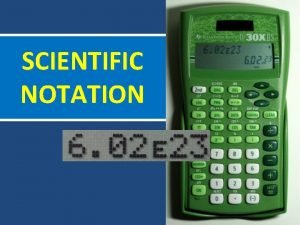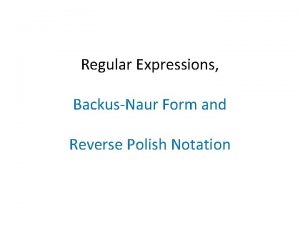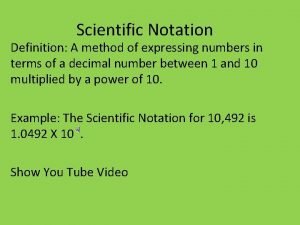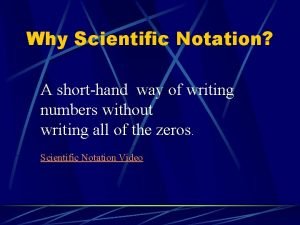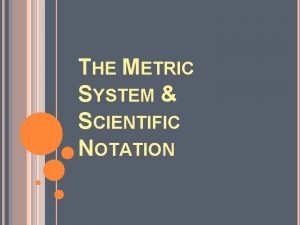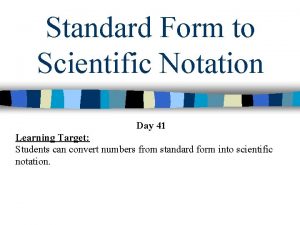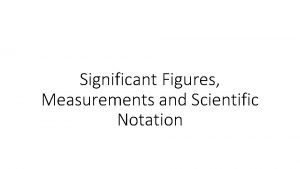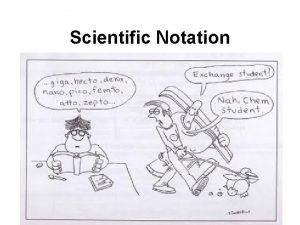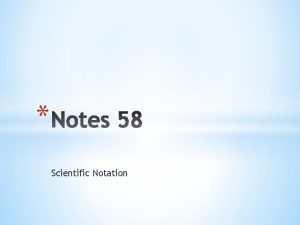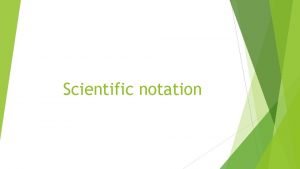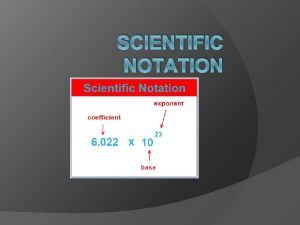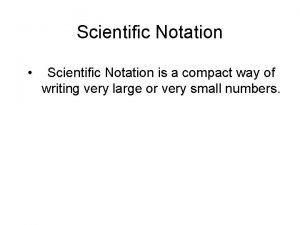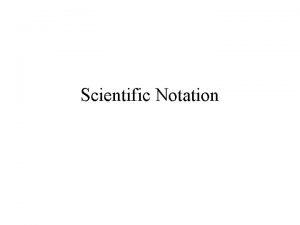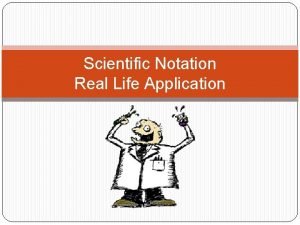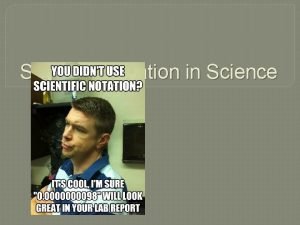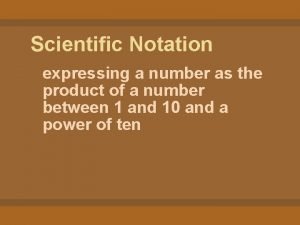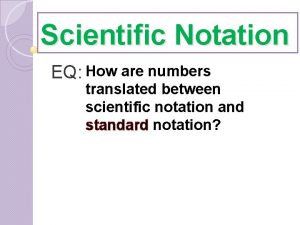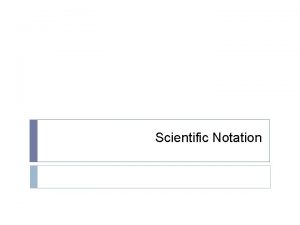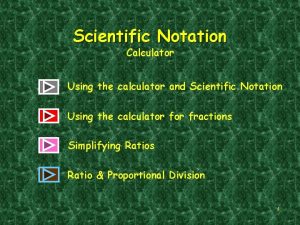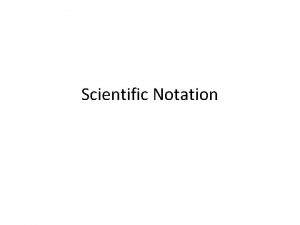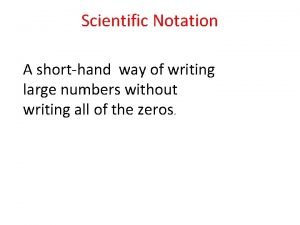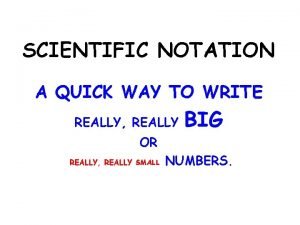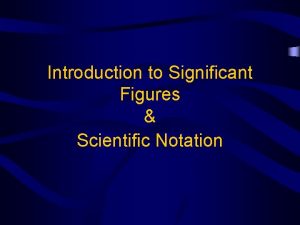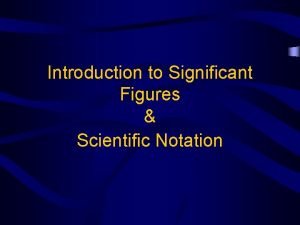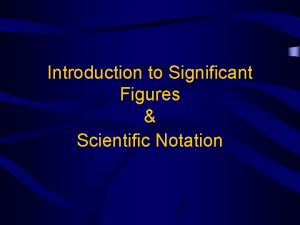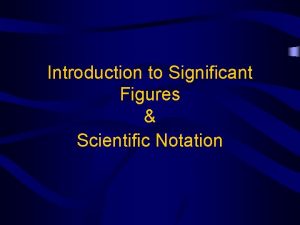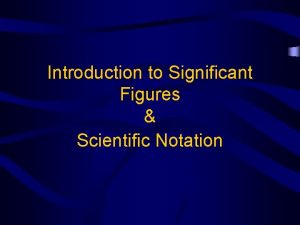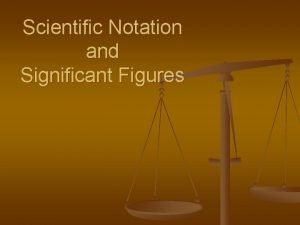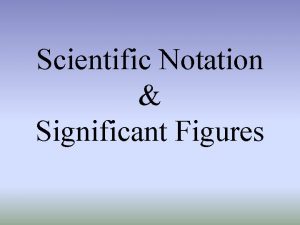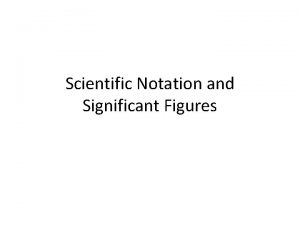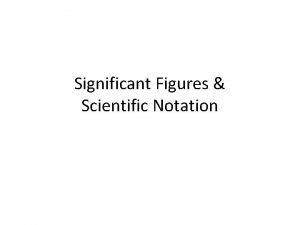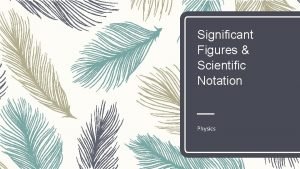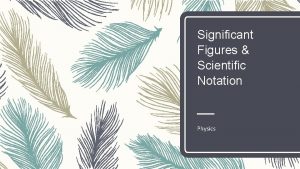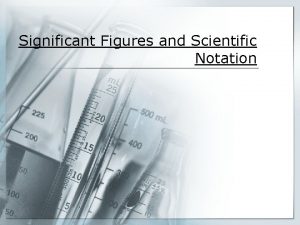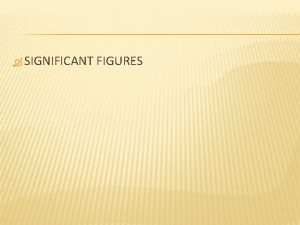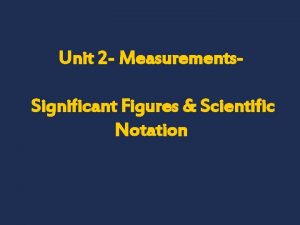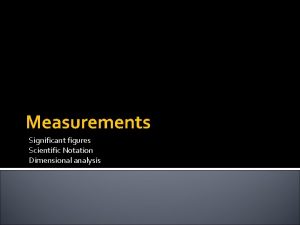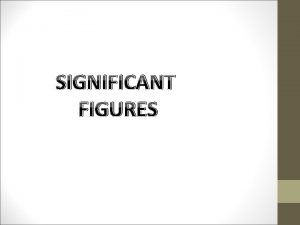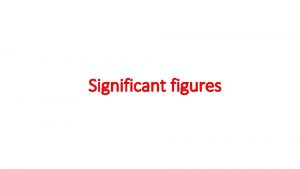Introduction to Significant Figures Scientific Notation Significant Figures
































- Slides: 32

Introduction to Significant Figures & Scientific Notation

Significant Figures • Scientist use ________ to determine how ________ a measurement is. • Significant digits in a measurement include all of the ________ plus one ________.

For example… • Look at the ruler below • What would be the measurement in the • correct number of sig figs? ________

Let’s try this one • Look at the ruler below • What would be the measurement in the • correct number of sig figs? ________

The same rules apply with all instruments • The same rules apply • Read to the last digit that you know • Estimate the final digit

Let’s try graduated cylinders • Look at the graduated cylinder below • What would be the measurement in the correct number of sig figs? • ________

One more graduated cylinder • Look at the cylinder below… • What would be the measurement in the • correct number of sig figs? ________

Rules for Significant figures Rule #1 • All non zero digits are ALWAYS significant • How many significant digits are in the following numbers? 274 _______ 25. 632 _______ 8. 987 _______

Rule #2 • All zeros between significant digits are • ALWAYS significant How many significant digits are in the following numbers? 504 _______ 60002 _______ 9. 077 _______

Rule #3 • All FINAL zeros to the right of the decimal • ARE significant How many significant digits are in the following numbers? 32. 0 _______ 19. 000 _______ 105. 0020 _______

Rule #4 • All zeros that act as place holders are NOT significant • Another way to say this is: zeros are only significant if they are between significant digits OR are the very final thing at the end of a decimal

For example How many significant digits are in the following numbers? 1) 2) 3) 4) 5) 0. 0002 6. 02 x 1023 100. 000 150000 800 1) _______ 2) _______ 3) _______ 4) _______ 5) _______

Rule #5 • All counting numbers and constants have • an infinite number of significant digits For example: 1 hour = 60 minutes 12 inches = 1 foot 24 hours = 1 day There are 30 students in the class

How many significant digits are in the following numbers? 1) 2) 3) 4) 5) 6) 7) 0. 0073 100. 020 2500 7. 90 x 10 -3 670. 00001 18. 84 1) _______ 2) _______ 3) _______ 4) _______ 5) _______ 6) _______ 7) _______

Rules Rounding Significant Digits Rule #1 • If the digit to the immediate right of the last significant digit is less that 5, do not round up the last significant digit. • For example, let’s say you have the number 43. 82 and you want 3 significant digits

Rounding Rule #2 • If the digit to the immediate right of the last significant digit is greater that a 5, you round up the last significant figure • Let’s say you have the number 234. 87 and you want 4 significant digits

Rounding Rule #3 • If the number to the immediate right of the last significant is a 5, and that 5 is followed by a non zero digit, round up • 78. 657 (you want 3 significant digits)

Rounding Rule #4 • If the number to the immediate right of the last significant is a 5, and that 5 is followed by a zero, you look at the last significant digit and make it even. • 2. 5350 (want 3 significant digits)

Say you have this number • 2. 5250 (want 3 significant digits)

Let’s try these examples… 200. 99 (want 3 SF) _______ 18. 22 (want 2 SF) _______ 135. 50 (want 3 SF) _______ 0. 00299 (want 1 SF) 98. 59 (want 2 SF) _____________

Scientific Notation • Scientific notation is used to express very • • _______ or very _______ numbers I consists of a number between _______ followed by _______ to an _______ The _______ can be determined by the number of _______ you have to move to get only 1 number in front of the decimal

Large Numbers • If the number you start with is greater than 1, the exponent will be _______ • Write the number 39923 in scientific notation

Small Numbers • If the number you start with is less than 1, the exponent will be _______ • Write the number 0. 0052 in scientific notation

Scientific Notation Examples Place the following numbers in scientific notation: 1) 99. 343 1) _______ 2) 4000. 1 2) _______ 3) 0. 000375 3) _______ 4) 0. 0234 5) 94577. 1 4) _______ 5) _______

Going from Scientific Notation to Ordinary Notation • You start with the number and move the • • decimal the same number of spaces as the _______. If the exponent is _______ , the number will be greater than 1 If the exponent is _______ , the number will be less than 1

Going to Ordinary Notation Examples Place the following numbers in ordinary notation: 1) 2) 3) 4) 5) 3 x 106 6. 26 x 109 5 x 10 -4 8. 45 x 10 -7 2. 25 x 103 1) _______ 2) _______ 3) _______ 4) _______ 5) _______

Significant Digits Calculations

Rules for Addition and Subtraction • When you _______ or _______ measurements, your answer must have the same number of _______ as the one with the fewest • For example: 20. 4 + 1. 322 + 83

Addition & Subtraction Problems 1) 1. 23056 + 67. 809 = 1) _______ 2) 23. 67 – 500 = 2) _______ 3) 40. 08 + 32. 064 = 3) _______ 4) 22. 9898 + 35. 453 = 4) _______ 5) 95. 00 – 75. 00 = 5) _______

Rules for Multiplication & Division • When you _______ and _______ numbers you look at the TOTAL number of _______ NOT just decimal places • For example: 67. 50 x 2. 54

Multiplication & Division Problems 1) 890. 15 x 12. 3 = 1) _______ 2) 88. 132 / 22. 500 = 2) _______ 3) (48. 12)(2. 95) = 3) _______ 4) 58. 30 / 16. 48 = 4) _______ 5) 307. 15 / 10. 08 = 5) _______

More Significant Digit Problems 1) 18. 36 g / 14. 20 cm 3 1) _______ 2) 105. 40 °C – 23. 20 °C 2) _______ 3) 324. 5 mi / 5. 5 hr 3) _______ 4) 21. 8 °C + 204. 2 °C 4) _______ 5) 460 m / 5 sec 5) _______
 Scientific notation significant figures worksheet
Scientific notation significant figures worksheet Engineering notation example
Engineering notation example Scientific notation
Scientific notation Infix equation
Infix equation Reverse polish notation adalah
Reverse polish notation adalah Polish notation
Polish notation Scientific notation definition
Scientific notation definition 150 000 scientific notation
150 000 scientific notation 7 500 000 000 000 000 000 in scientific notation
7 500 000 000 000 000 000 in scientific notation Ladder method physics
Ladder method physics 97 000 000 in scientific notation
97 000 000 in scientific notation 87 pg in scientific notation
87 pg in scientific notation Incorrect scientific notation examples
Incorrect scientific notation examples Scientific notation vocabulary words
Scientific notation vocabulary words Express 4,980,000, 000 in scientific notation
Express 4,980,000, 000 in scientific notation Rules of scientific notation
Rules of scientific notation 67x10^6 in scientific notation
67x10^6 in scientific notation 7x10x10x10
7x10x10x10 53 in scientific notation
53 in scientific notation What is scientific notation
What is scientific notation Scientific notation facts
Scientific notation facts Is 39 rational or irrational
Is 39 rational or irrational Used to express very large or very small numbers
Used to express very large or very small numbers 450 000 000 in scientific notation
450 000 000 in scientific notation What is 637 000 in scientific notation
What is 637 000 in scientific notation What is standard notation
What is standard notation Scientific notation define
Scientific notation define Scientific notation graphic organizer
Scientific notation graphic organizer Express in scientific notation calculator
Express in scientific notation calculator 65 000 000 in scientific notation
65 000 000 in scientific notation Scientific notation shorthand
Scientific notation shorthand Proper scientific notation
Proper scientific notation Significant figures meaning
Significant figures meaning


